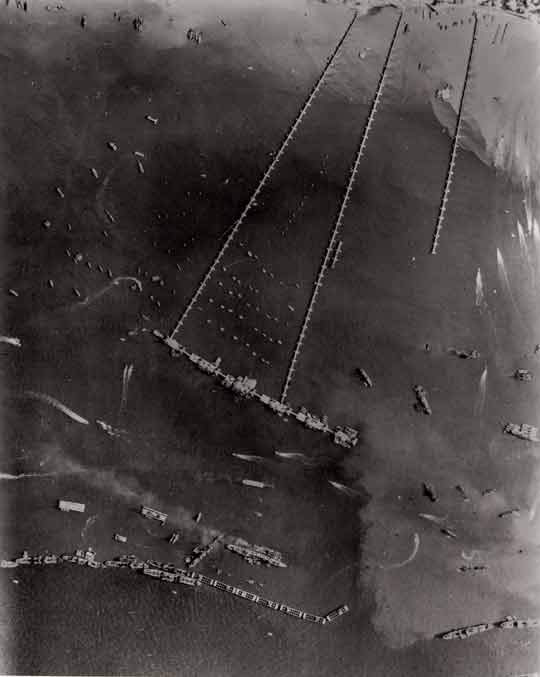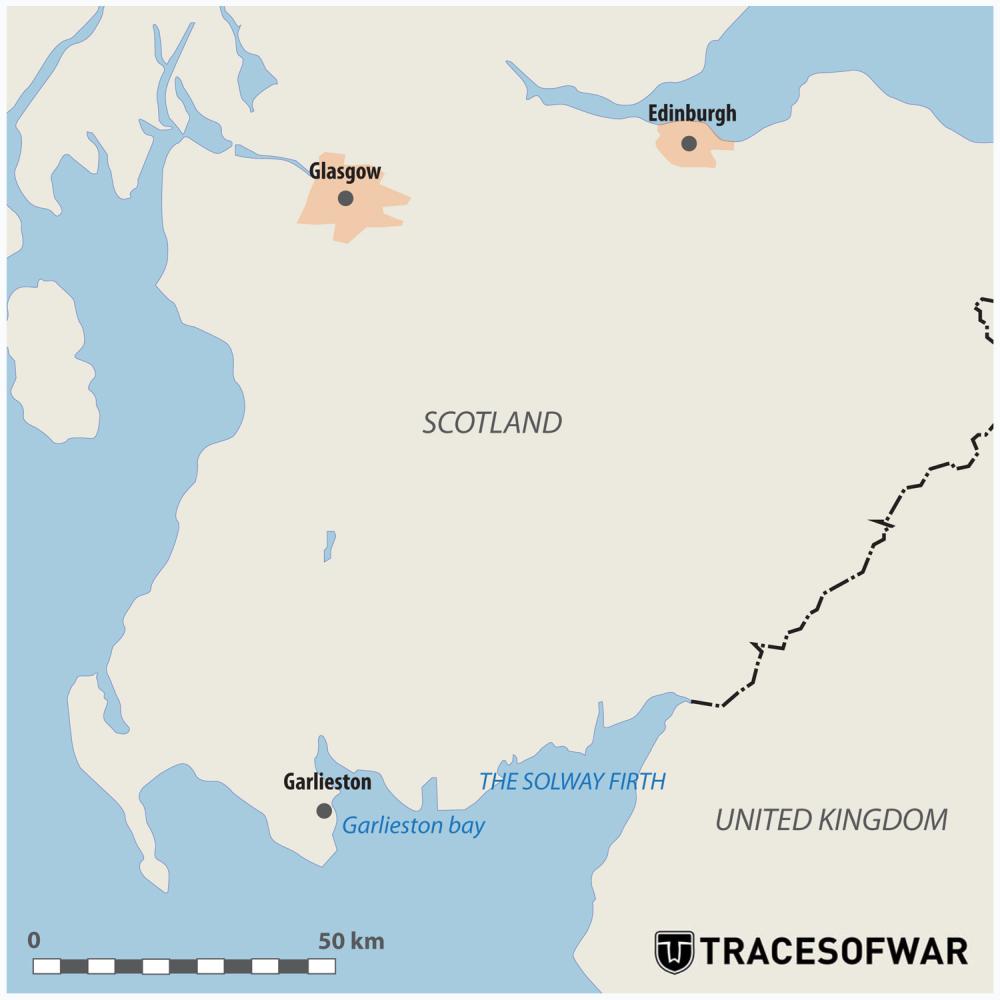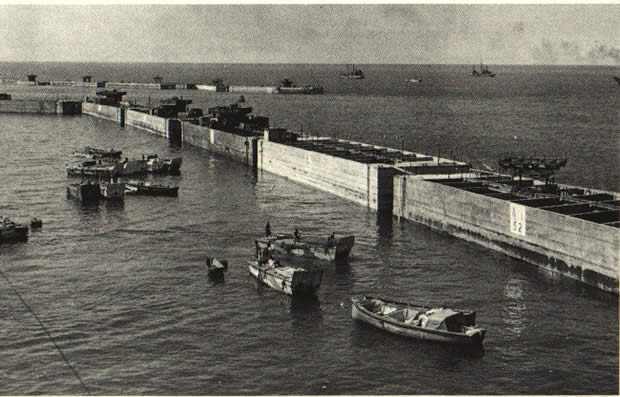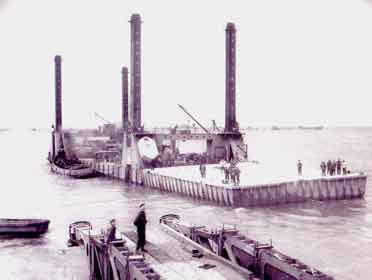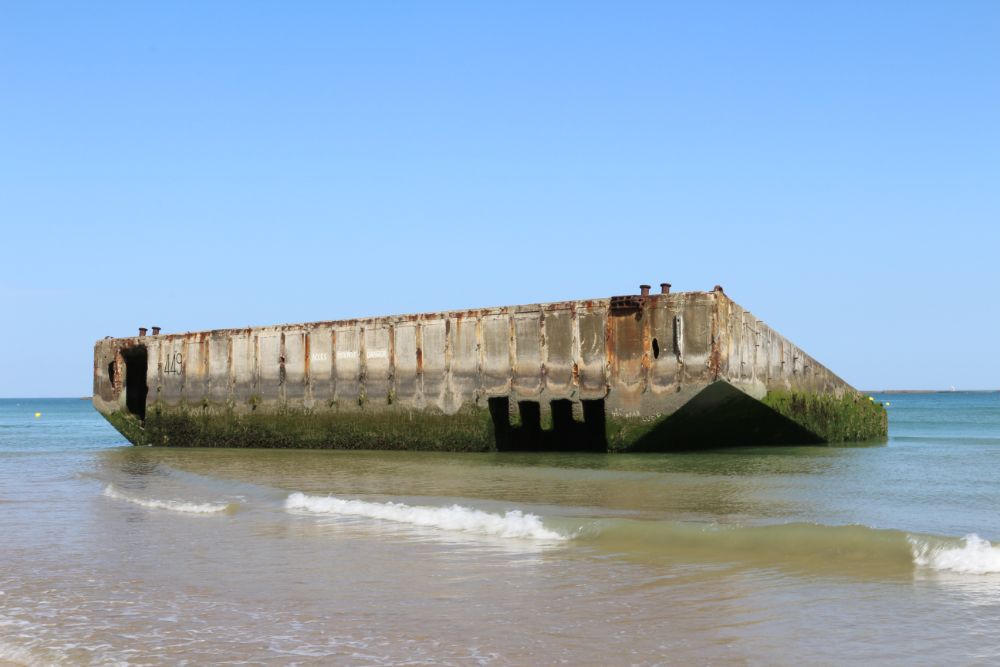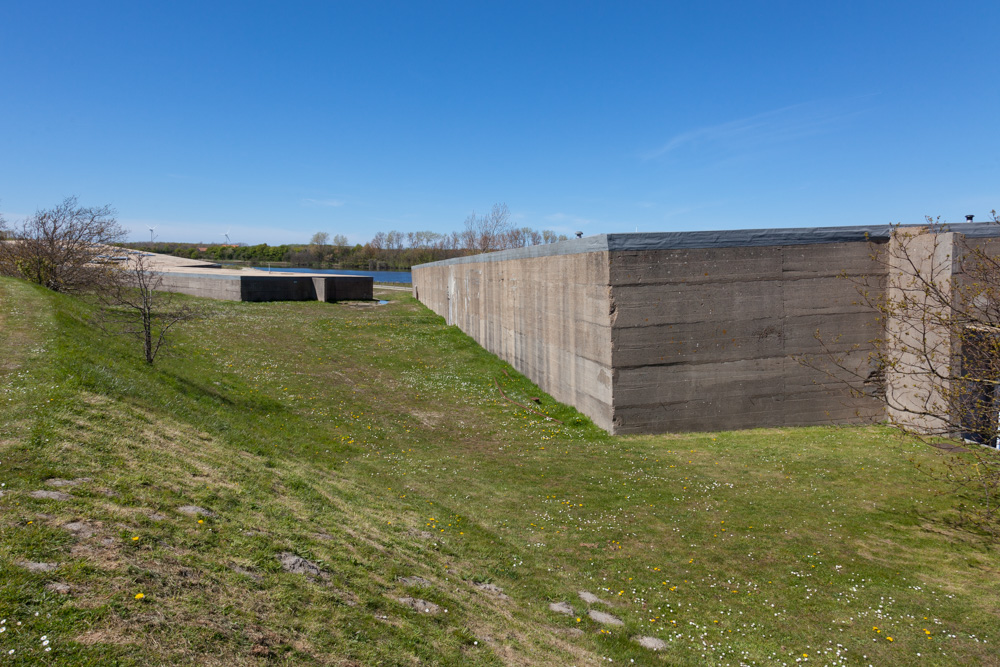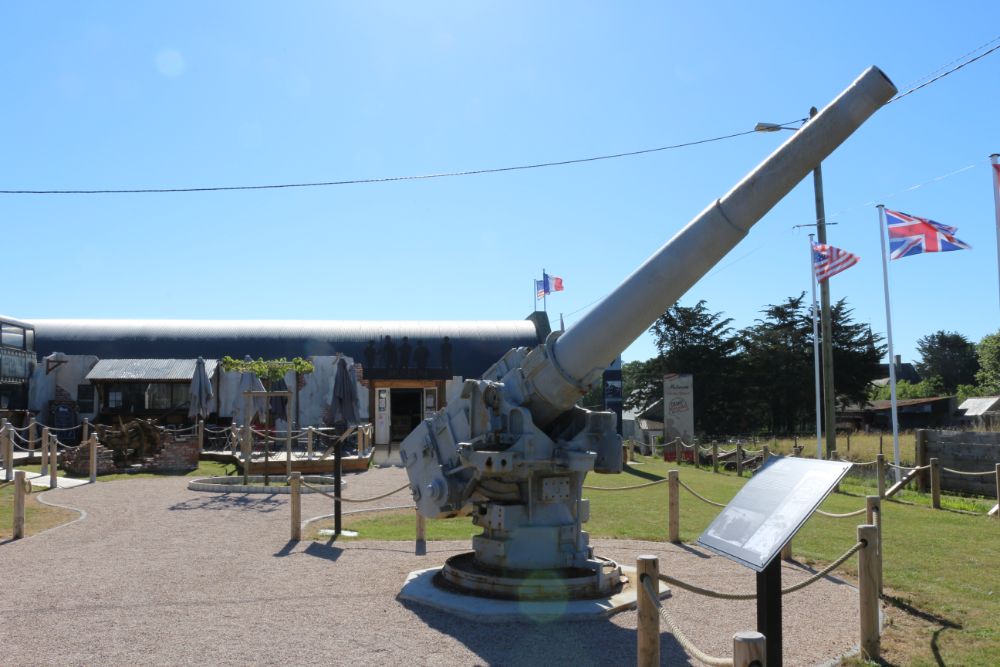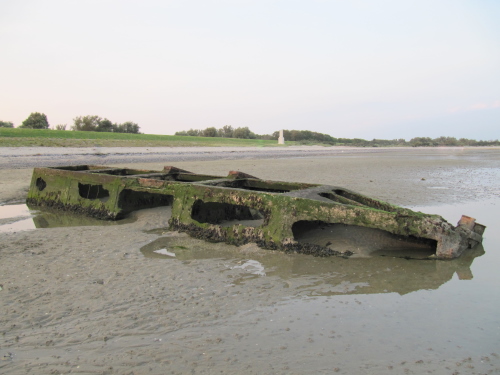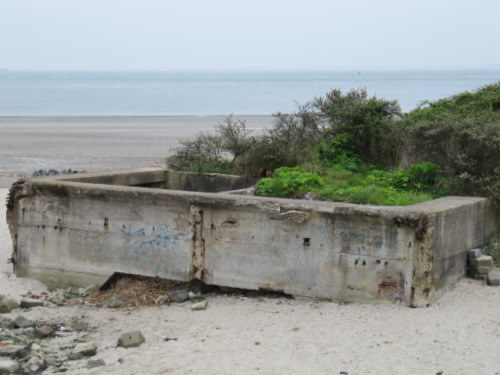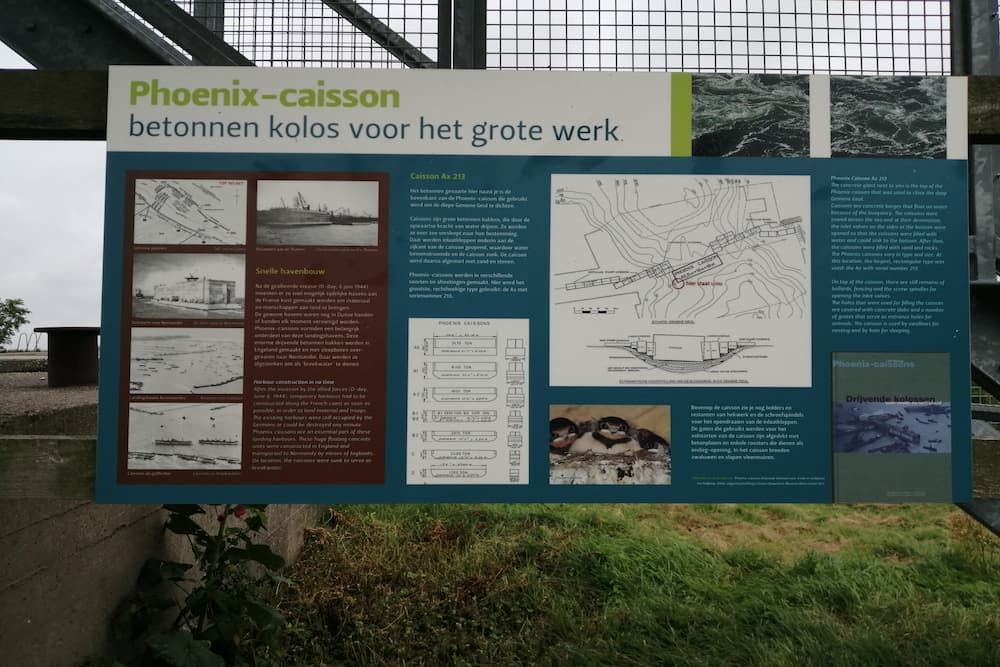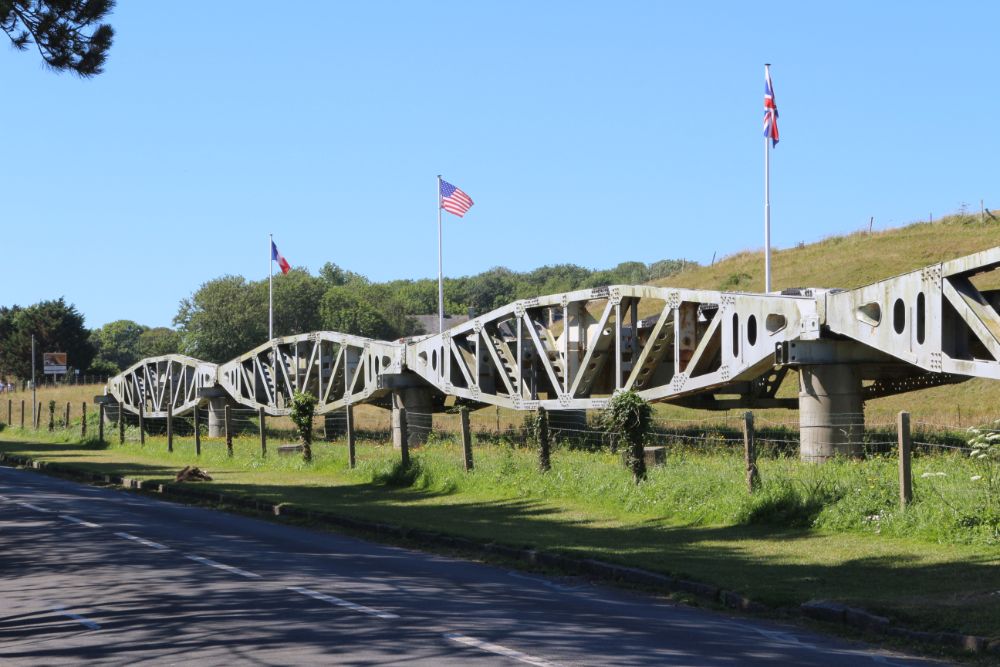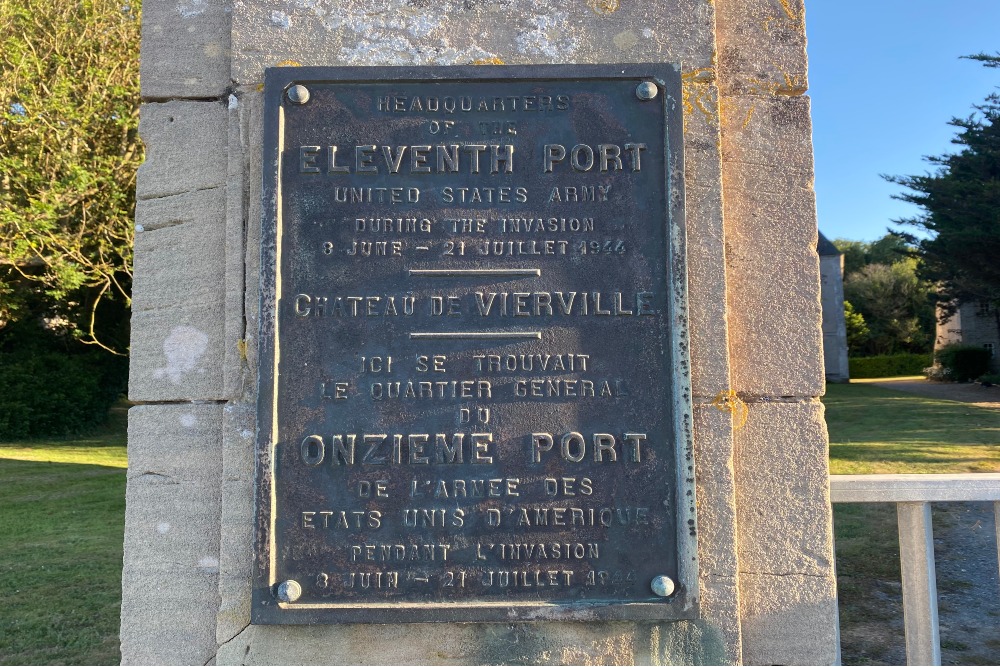Supply problems
Supply problems
The allied invasion on the European mainland brought several problems with it. The most important was the problem of supply. Next to supplying the troops that had already landed new divisions had to be transported in order to expand the force on shore. These troops had to be supplied as well.
Possible solutions to the problem of supplying the landing in Normandy were a frontal assault at a large harbour or to land supplies on the beach with the aid of landing ships. Already before the dismal raid on Dieppe, conquering a large port was deemed to be almost impossible, for the Atlantikwall was at its strongest around and in these harbours. Next to this,German troops were expected to mine and destroy the installations in a harbour, rendering it out of use for months on a row before being fully operational again for supplying the landings.
The possibility of landing supplies, troops and vehicles directly on the beaches was considered to be a possible short term solution but would not be adequate for the structural arrival of supplies. Freighters would have to unload their cargo in landing boats or on pontoons that would ferry to the coast after which the cargo would be loaded unto trucks. The landing boats would suffer a lot of wear and tear on their hulls and thus require more maintenance. Besides, using these boats could only be done once every tide because the boats would have to wait for the high tide in order to get from the beach. Supply would in this way be very slow and would require a large number of vessels. Various small fishing ports at the coast could help out, but their capacity was not big enough.
Transportation 5 (Tn.5)
Headed by Major Allan H. Beckett in the beginning of 1941,a new organisation within the Ministry of Defence was founded with the name Transportation 5 (Tn.5). Tn.5 got the task to supervise construction of harbour facilities with related equipment as dredgers, floating cranes, repair vessels as well as the construction of several rail roads in England. The experience gained by this organisation and the training of qualified personnel which this involved, made Tn.5 the ideal organisation to find a solution for the supply problem.
Floating harbours
The solution to the supply problem was ,according to Tn.5, floating harbours. Various parts that were needed for the floating harbour were already invented by Tn.5 for other applications.Some parts were already in a prototype stage and were subjected to tests in e.g. stormy weather.
The plan of Tn.5 prevised a floating harbour which would be built in parts in Great Britain and which would be towed by tugs to the area of the invasion. After this,the parts were to be assembled in place. This plan was received in a rather reserved way at first because of the breathtaking complexity in design, planning and secrecy.However, on 23 Augustus, 1943,during the Largs-conference where a large number of people was present who were involved in the planning of Overlord, agreement was reached on the plan through the personal action of Lord Louis Mountbatten. During the Quebec conference called Quadrant, the COSSAC plan, the overall plan for operation Overlord, was accepted by,among others , Franklin Roosevelt and Winston Churchill. One of the parts of the plan was the floating harbour.After this a central managing board was created that would take care of the design and construction of special piers, artificial harbours and breakwaters .They would organize and manage the development of the conquered harbours. For the command of the two artificial harbours at a later hour Vice-Admiral W. G. Tennant was appointed. Tennant was chosen because he had shown considerable skills during the evacuation from Dunkirk.On a certain stage during the evacuation of the 338,000 troops from the beaches of Dunkirk it was decided to drive the trucks from the British Army into the sea, thus creating an artificial pier and in the same time denying the Germans the use of these trucks.These would suffer considerable from the salt water.
The codename Mulberry was chosen for the project after the whole project of the floating harbour proceeded a long way.. During the Quebec conference in 1943 it was decided that two Mulberries had to be made. Mulberry A for the Americans at Colleville and Mulberry B for the British at Arromanches. It was decided that the various parts for the artificial harbours should be ready in May, 1944. Furthermore it was decided that it should be feasible to construct the harbours in two weeks on location and each harbour was supposed to have a capacity comparable to Dover, which is 6,000 tonnes and 1,250 vehicles a day.
Plan of supply
The total supply of the troops in Normandy was provided for only partially by the Mulberries. The port of Cherbourg was to be conquered and made operational as soon as possible. According to estimates this would take certainly two months after the conquest.The small fishing ports that lay within the landing area like Carentan, Grandcamp, Isigny, Barfleur and St. Vaast all contributed their share from within several weeks after the landing, although they could not be used during the low tide.
The invasion beaches that did not get an artificial harbour received breakwaters. In this way a sheltered strip of beach was created so that landing ships could unload. These breakwaters consisted of scuttled blockade ships and caissons.
Definitielijst
- invasion
- Armed incursion.
- mine
- An object filled with explosives, equipped with detonator which is activated by either remote control or by colliding with the targeted object. Mines are intended to destroy of damage vehicles, aircrafts or vessels, or to injure, kill or otherwise putting staff out of action. It is also possible to deny enemy access of a specific area by laying mines.
- raid
- Fast military raid in enemy territory
- Transportation 5 (Tn.5)
- Department of the British Ministry of Defence responsible for the harbours and train facilities. This department was also responsible for the design and construction of the Mulberry harbours.
Images
Designs, testing and planning
Introduction
When it was decided to build the mulberries many parts of them still had to be designed, built and tested. This led to ideas, protototypes and methods which were remarkable and deserve mentioning. The designs that eventually would form the parts of the mulberries are described in the following paragraph.
Test area
For experimenting with and the testing of the various mulberry parts a good testing area was needed. This area had to resemble Normandy with respect to the large difference in tides, the underground consisting of sand and rock and the area had to be swept by heavy gales. Additionally the area had to be easily secluded from the outside world with an eye to secrecy and security. The testing ground which met these specifications was in Scotland near the fishing village of Garlieston in Wigtownshire. The sea area is known as the Solway Firth.
Floating roads
Winston Churchill himself interfered with the artificial harbour and its construction. He wanted to be updated on a regular basis on developments and problems.A famous memo from Churchill of 30 May,1942, on the floating roads said: "They must float up and down with the tide. The anchor problem must be mastered. Let me have the best solution worked out. Don’t argue the matter. The difficulties will argue for themselves". In all, three ideas for floating roads were elaborated, of which two didn't make it.
One idea of the Welshman Hugh Iorys Hughes was to use concrete caissons known as Hippo’s and to construct a metal frame on top of these.On top of this frame,bridge parts were to be placed so that a elevated road would form. It became soon clear that this idea would not make it for Churchill's wish for a road moving with the tide was not met. Besides, the construction was difficult to produce and to assemble.Possible capsizing due to the height of the road and the heavy vehicles on it was a real problem.In all, a total of three were built and tested at Rigg Bay, Garlieston.
In 1952, Hippo 1 was towed from Garlieston to Larne Harbour where it was used for a development of Curran Quay. In 1953, Hippo2 was also towed to Larne for the same purpose. One of the Hippos is still in Rigg Bay and until ca 2006, the steel structure remained intact until destroyed by a storm. Remarkably, in 1993, part of one of the Hippos at Larne Harbour was removed from the complete structure, towed to Carlingford Marina and sunk in the outer breakwater wall (next to Cretefield, a 1919 concrete barge built Warrenpoint).
The second idea was called "Swiss Roll" from the briljant mathematician Ronald Marsden Hamilton. It can best be described as a giant mat that floated on sea. Testing and experimenting with the device caused some hilarious and surprising moments.In the end the mats were used in Normandy for unloading troops from landing ships so that the troops kept their feet dry. The mats were considered not suitable for heavy vehicles, however.
Breakwaters
Calm water in the Mulberry was considered to be crucial for the succes of the harbour.Breakwaters were to be created in a ring surrounding the harbour. Plans for artificial breakwaters were present since 1940, but were never put into practice.Next to the three parts that were to form the artificial breakwater, there were ideas for gigantic inflatabable rubber shapes. There was an idea for a pipe under water, filled with pressurized air that would escape through tiny holes in the pipe and so constituting a kind of a "bubble breakwater." Another idea, which was considered to be absurd, was from an American general who suggested that airplane engines should be placed on boats around the harbour to counter strong winds.
Images
Parts of an artificial harbour
The breakwaters that received the name Bombardon constituted the outer ring of breakwaters.These Bombardons were floating crosses with a length of 65 meters, a height of eight meters and a depth of six meters. They were to be scuttled while connected by anchors with a space of 15 meters in between. These were floating crosses with a length of 65 metres, a height of 8 metres and a draft of 6 meters . The anchors were to fix them to each other and to the sea bed. Initially,the navy built them from steel, but because of the lack thereof they switched to thin walled concrete. The Bombardons had watertight compartments that could partially be floaded in order to submerge them.
The various parts of the complete harbour were the responsibility of Navy and Army. The Navy was responsible for the Bombardons and the blockade ships, the so called Gooseberries ,and the Army was responsible for the rest. The Bombardon was a completely new method for a breakwater which was an idea of Lieutenant Lochner. The concept was that a wave that runs into an solid object loses the larger part of its force. In reality this concept did not work as well as anticipated and during the storm of 19 June,unhinged Bombardons caused troubles. Whether the Bombardons were an unmitigated succes or not remains a discussion to this very day.
Gooseberries
In order to achieve calmer water conditions in the harbours, 59 different ships on various locations were scuttled in front of the invasion beaches. In this way they served as breakwaters and so they created calmer waters for the smaller vessels to operate in. These 59 old ships consisted mainly of old freighters, besides several obsolete warships. These were the French battleship Courbet, the Dutch cruiser Sumatra, the British cruiser Durban and the British battleship Centurion. The acquaintance of this large number of vessels was not an easy one. The British Admiralty was not keen on wasting ships as breakwaters due to the huge losses that the U boats had inflicted.
A large advantage of the use of these obsolete vessels was that they could sail on their own power towards their scuttle location. In this way no tugs were needed. These tugs were in short supply anyway because they were needed to tow the various parts of the Mulberries across the Channel to Normandy. Those vessels with a high superstructure were used as living quarters or as offices.
Phoenix-caissons
Next to the Gooseberries, special caissons were used that were scuttled one after another to be used as breakwaters. The designing of the caissons happened so quickly that the construction of the first caissons already had started before the drawings were complete. For the two Mulberries, a total of 146 was needed. In seven months, a total of 212 was built in six different sizes. Next to the problem of obtaining sufficient concrete, steel, personnel and construction facilities in a war economy that was strained to its limits, time was an additional problem.
The largest Phoenix caisson had a water displacement of 6,044 tonnes whereas the smallest displaced 1,672 tonnes. The size was connected to the place where the caisson was to be sunk.The largest model was 60 metres long, 17 metres wide and 18 metres high. Constructing such a vast caisson initially took about four months. Later on, due to experience gained in the production process, this was reduced to two months. Not enough dry docks were available for the construction of the caissons for these were needed for the landing craft. For this reason the caissons were constructed in dug out areas on the river Thames and Southampton Waters. By the way, this principle was also used during the Dutch Delta works. As soon as the lower part of a caisson was constructed, the dug out part was flooded. In this way the caisson started to float. Following this the basis was towed towards a quay where it was completed. Hereafter the caisson was scuttled on a temporary location in order to remain out of sight of the German intelligence services and of German air reconnaissance. A short time after D-Day the caissons were towed to Normandy by tugs and were scuttled in their respective positions within 22 minutes. In several Phoenix caissons quarters were built for the crew. There was also space for ammunition storage. On a platform there was place for a Bofors 40 mm anti aircraft gun.
Whale-piers and Lobnitz-piers
The quays where the ships could unload were large rectangular constructions of concrete and steel. On each corner there was a large steel pillar of 30 metres that stood on the sea bed.The entire pier could move along with the tide through pullies on the pillars. Moored ships could unload their cargo on waiting trucks with their own cranes or floating cranes.
Within the piers there were quarters for personnel, technical rooms and storage room. On these piers facilities existed to aid in unloading the larger landing ships as the LCT (Landing Craft Tank) and LST (Landing Ship Tank) more rapidly.The vehicles could drive out of the ships without the necessity to be hoisted out of the ships. For this purpose, on some of the piers a metal surface was fitted that ran gradually into the sea, creating a sort of an artificial beach.. The LST and LCT could moor on the pier with their bows against it, open their large doors and the vehicles could move on the pier on their own power.Special constructions from wood were present on the piers so that the vehicles on the top deck of the LST's could drive unto the piers on their own propulsion.
Floating roads
In order to get the supplies and vehicles from the piers unto the main land, floating roads were developed. These consisted of a kind of bridge elements on floating pontoons. These pontoons, also called Beetles, moved along with the tide and during low tide they lay on the beach. Most pontoons were made of concrete and some were made of steel because they would lay on rock in stead of the beach during ebb. These floating roads could, depending on the model, carry 25 to 40 tonnes of vehicles and were meant to be used as one way roads.The anchoring of these floating roads was designed to keep the roads together even during storms.
These floating roads were towed from Great Britain to Normandy in lengths of 150 metres but they proved to be extremely vulnerable on open seas. Half of them was lost during the cross Channel trip. On the beach at Arromanches one can still find several of these pontoons.
Definitielijst
- battleship
- Heavily armoured warship with very heavy artillery.
- cruiser
- A fast warship with 8,000 – 15,000 ton displacement, capable to perform multiple tasks such as reconnaissance, anti-aircraft defence and convoy protection.
- D-Day
- The day of the long awaited invasion of western Europe in Normandy, France, 6 June 1944. After a long campaign of deception the allies attacked the coast of Normandy on five beaches to begin their march on Nazi Germany. Often explained as Decision Day, though this is entirely correct. The D stands for Day as generally used in military language. In this case it means an operation beginning on day D at hour H. Hence “Jour J“ in French.
- invasion
- Armed incursion.
Images
The harbours in practice
All parts of the Mulberry harbours were built on the southern shore of Great Britain. In this way the crossing to Normandy was kept relatively short.
6 and 7 June
The night before D-Day the Gooseberries- blockade ships were prepared so that they would arrive on 7 June at their location and so that they could shelter the invasion beaches.Tugs started on 6 June with the crossing of the first elements.Admiral Ramsay, in the last moment, decided to scuttle only one row of Bombardons ( cross shaped breakwaters) in stead of the two rows originally planned in order to save tugs and manpower. This decision was criticized after the storm of 19 June.
On 7 June, German coastal batteries were still active and claimed to have sunk two ships in front of Utah Beach. This was in itself correct but they were blockade ships that were sunk at their intended locations.
10 June
Mulberry A (Americans) consisted of six blockade ships, only two Phoenix-caissons and twelve cruciform breakwaters. The slow progress was due to enemy fire in the harbour area. Mulberry B (British) had progressed a lot further.They were busy with the quays and had started the LST quays. The breakwaters were largely in place. Work continued night and day under protection of artificial smoke to stay out of sight from German observers.
11 June
All blockadeschips, the Gooseberries,were in place before the invasion beaches Utah, Omaha, Gold, Juni and Sword.
14 June
On this date all cruciform breakwaters, the Bombardons, lay in place in both harbours. In Mulberry A a quay was ready. At Mulberry B a floating road to the beach was laid. Due to losses during transport the construction of the LST quays was delayed.
16 June
The central floating road of Mulberry A was ready and was hinged to the quay.The Germans slowly realized the importance of the harbours and tried to attack them from the air. These attacks were not a succes due to the smoke screens, large quantities of anti aircraft artillery, allied fighters and the balloons over the harbours and beaches.
17 June
Almost all breakwaters, Bombardons, Gooseberries and Phoenix caissons lay in their planned positions in front of the invasion beaches. The floating roads were for their greatest part en route to Normandy from England. At this stage, the British harbour was further developed than her American counterpart. This was mainly because the British had had the opportunity to train with the materiel. The Americans had not been able to do this because of the late arrival of their various harbour parts.
19 June until 22 June
The flow of supplies that was going smoothly up until then faltered on 19 June. Winds increased and a storm developed, the like of which had not been seen for decades. The harbour was built to be able to stand a storm, but the forces that were unleashed here were something that had not been foreseen. During the gale over 800 ships stranded, part of which was beyond repair and a total loss.
The American harbour was not yet complete and therefore more vulnerable to the storm. The Americans were less precise in placing the various parts and the breakwaters, so that the storm could inflict more damage. A group of 16 LCT’s looked for shelter, but caused damage by colliding with parts of the harbour. The results were catastrophical and would mean the end of the American harbour. It was decided that those parts that could still be saved would be transferred to the British Mulberryhaven. This was acceptable because the conquest of Cherbourg was imminent. The Americans, as a result of the interruption in the supply, got in short supply of certain types of ammunition, at a moment that these were so desperately needed for the attack on Cherbourg. It was decided to strand eight ships with ammunition. Ammunition and fuel received top priority.
The British harbour got through the storm reasonably well, because of its more favourable position and because of the precision with which the British had placed the breakwaters and the thoroughness with which they had anchored them. There was some damage but that could be repaired. The parts of the American harbour contributed to the repairing of the harbour. Shortages in ammunition did not occur on the British side because ,even during the gale, they had managed to unload 1,500 tonnes a day.
After the storm
After the storm the normal supply situation was resumed and the British harbour was completed and repaired. All parts that were on their way from England had been lost or had been damaged during the storm.Eventually the British harbour was even expanded with extra quays so that an additional 500 metres was available.This may have been a factor that the planne 6,000 tonnes a day were surpassed.
In order to keep the American supply in shape the beach where the harbour was planned was levelled so that ships could simply strand themselves, be unloaded and move again with high tide.In this way they could be unloaded straight into trucks that stood at the ready. Although this method was not ideal, it assured a steady flow of supplies.
Definitielijst
- D-Day
- The day of the long awaited invasion of western Europe in Normandy, France, 6 June 1944. After a long campaign of deception the allies attacked the coast of Normandy on five beaches to begin their march on Nazi Germany. Often explained as Decision Day, though this is entirely correct. The D stands for Day as generally used in military language. In this case it means an operation beginning on day D at hour H. Hence “Jour J“ in French.
- invasion
- Armed incursion.
Images
Closing the harbour
Preparing for winter
In the beginning of August it was decided to keep on using the harbour as long as the weather allowed.The harbour was prepared for use during the winter. By doing so, the original plan of using Cherbourg as main port was rejected. Cherbourg could still not be used because of the thorough demolition the Germans had wrought there.Preparing for winter would happen by placing extra Phoenix caissons. In this way,the harbour would be better protected against storm and high waves.
Closing of the harbour
The closing of the harbour came earlier than expected. The seizure of Antwerp, on 4 September,and of Le Havre, on 12 September,effectively ended the lack of harbour facilities. It would still take a long time before Antwerp could be used, but le Havre was first used on 9 October. The Mulberry harbour ,at this stage, was only used for unloading American Liberty ships and for accumulating emergency stocks.Finally the harbour was shut down on 31 October.
The following reasons for the closure were given:
- Belgian and Dutch ports could be used which were nearer to the front
- Existing ports offered better rail possibilities. Mulberry B had no connection to the railroad network which meant that all further transport had to be done by truck.
- The rapid degradation of the roads to and from the Mulberry harbour. The roads were totally disrupted because of the huge number of vehicles that had travelled over them. The roads had to be laid down once more.
- The silting of the harbour. Sandbanks appeared around the harbours; the harbour facilities were silting rapidly.
Recycling the various harbour parts
The various parts of the Mulberries could well be used after deconstruction. The bridge parts of the floating roads were used as normal bridges. In this way ,Bailey Bridge material was saved.The Phoenix caissons were ,where possible, refloated and were used for repairing harbours like Le Havre and for repairing the dykes at Walcheren which had been deliberately bombed by the allies. After VE Day, various steel parts of the harbour were handed over to the French, who could deploy the steel in approximately 60 reconstruction projects.
Conclusion
The artificial harbours were seen as an unmitigated succes, even though the American Mulberry was cancelled. It is remarkable that the secrecy during the construction remained intact. This despite the fact that over 8,000 people, civilian as well as military, had participated in the project. The harbour operated for almost six months. It was intended to last only for three months. The British harbour had been designed to process 6,000 tonnes a day. This tonnage was even surpassed for a period of three months when it processed an average of 6,765 tonnes a day. This is a staggering 48% of all supplies needed for the British armies. In this way, the harbour contributed crucially to the success of the invasion and to the operations in Normandy and the rest of France.
Definitielijst
- invasion
- Armed incursion.
Images
 Mulberry Harbour Whale reused. Source: Christopher Long.
Mulberry Harbour Whale reused. Source: Christopher Long. 3D animated film of the mulberry harbour of Arromanches in 1944.Made by Dassault. Source: YouTube.
3D animated film of the mulberry harbour of Arromanches in 1944.Made by Dassault. Source: YouTube.Information
- Article by:
- Frank van der Drift
- Translated by:
- Peter ter Haar
- Published on:
- 19-01-2025
- Feedback?
- Send it!
Related sights
Related books
Sources
- FERRAND, ALAIN, Arromanches, Orep, 2007.
- WALTER, ROY e.a., A Harbour Goes to War, South Machars Historical Society, 2000.
With thanks to Richard Lewis for his additional information on Hippo 1 and 2 by pointing us to the following site:
